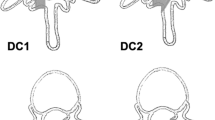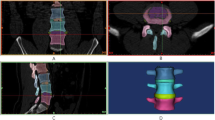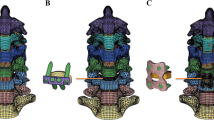Abstract
Purpose
Adjacent level degeneration that occurs above and/or below long fusion constructs is a documented clinical problem that is widely believed to be associated with the considerable change in stiffness caused by the fusion. Some researchers have suggested that early degeneration at spinal joints adjacent to a fusion could be treated by implanting total disc replacements at these levels. It is thought that further degeneration could be prevented through the disc replacement’s design aims to reproduce normal disc heights, kinematics and tissue loading. For this reason, there is a clinical need to evaluate if a total disc replacement can maintain both the quantity of motion (i.e. range) and the quality of motion (i.e. center of rotation and coupling) at segments adjacent to a long spinal fusion. The purpose of this study was to experimentally evaluate range of motion (ROM—the intervertebral motion measured) and helical axis of motion (HAM) changes due to one- and two-level Maverick total disc replacement (TDR) adjacent to a long spinal fusion.
Methods
Seven spine specimens (T8–S1) were used in this study (66 ± 19 years old, 3F/4 M). A continuous pure moment of ±5.0 Nm was applied to the specimen in flexion–extension (FE), lateral bending (LB) and axial rotation (AR), with a compressive follower preload of 400 N. The 5.0 Nm data were analyzed to evaluate the operated segment biomechanics at the level of the disc replacements. The data were also analyzed at lower moments using a modified version of Panjabi’s proposed “hybrid” method to evaluate adjacent segment kinematics (intervertebral motion at the segments adjacent to the fusion) under identical overall (T8–S1) specimen rotations. The motion of each vertebra was monitored with an optoelectronic camera system. The biomechanical test was completed for (1) the intact condition and repeated after each surgical technique was applied to the specimen, (2) capsulotomy at L4–L5 and L5–S1, (3) T8–L4 fusion and capsulotomy at L4–L5 and L5–S1, (4) Maverick at L4–L5, and (5) Maverick at L5–S1. The capsulotomy was performed to allow measurement of facet joint loads in a companion study. Paired t tests were used to determine if differences in the kinematic parameters measured were significant. Holm–Sidak corrections for multiple comparisons were applied where appropriate.
Results
Under the 5.0 Nm loads, L4–L5 ROMs tended to decrease in all directions following L4–L5 Maverick replacement (mean = 22 %, compared to the fused condition). Two-level Maverick implantation also tended to reduce L4–S1 ROM (mean 18, 7 and 31 % in FE, LB and AR, respectively, compared to the fused condition without TDR). Following TDR replacement, the HAM location tended to shift posteriorly in FE (at L5–S1), anteriorly in AR, and inferiorly in LB. However, although the above-mentioned trends were observed, neither one- nor two-level TDR replacement showed statistically significant ROM or HAM change in any of the three directions. At the identical T8–S1 posture identified by the modified hybrid analysis, the L4–L5 and L5–S1 levels underwent significant larger motions, relative to the overall specimen rotation, after fusion. In the hybrid analysis, there were no significant differences between the ROM after fusion with intact natural discs at L4–L5 and L5–S1 and the motions at those levels with one or two TDRs implanted.
Conclusions
The present results demonstrated that one or two Maverick discs implanted subjacent to a long thoracolumbar fusion preserved considerable and intact-like ranges of motion and maintained motion patterns similar to the intact specimen, in this ex vivo study with applied pure moments and compressive follower preload. The hybrid analysis demonstrated that, after fusion, the TDR-implanted levels are required to undergo large rotations, relative to those necessary before fusion, in order to achieve the same motion between T8 and S1. Additional clinical and biomechanical research is necessary to determine if such a kinematic demand would be made on these levels clinically and the biomechanical performance of these implants if it were.








Similar content being viewed by others
References
Auerbach JD, Jones KJ, Milby AH, Anakwenze OA, Balderston RA (2009) Segmental contribution toward total lumbar range of motion in disc replacement and fusions: a comparison of operative and adjacent levels. Spine (Phila Pa 1976) 34:2510–2517. doi:10.1097/BRS.0b013e3181af2622
Bertagnoli R, Yue JJ, Fenk-Mayer A, Eerulkar J, Emerson JW (2006) Treatment of symptomatic adjacent-segment degeneration after lumbar fusion with total disc arthroplasty by using the prodisc prosthesis: a prospective study with 2-year minimum follow up. J Neurosurg Spine 4:91–97. doi:10.3171/spi.2006.4.2.91
Cho KJ, Suk SI, Park SR, Kim JH, Choi SW, Yoon YH, Won MH (2009) Arthrodesis to L5 versus S1 in long instrumentation and fusion for degenerative lumbar scoliosis. Eur Spine J 18:531–537. doi:10.1007/s00586-009-0883-2
Cripton PA, Bruehlmann SB, Orr TE, Oxland TR, Nolte LP (2000) In vitro axial preload application during spine flexibility testing: towards reduced apparatus-related artefacts. J Biomech 33:1559–1568
Dmitriev AE, Gill NW, Kuklo TR, Rosner MK (2008) Effect of multilevel lumbar disc arthroplasty on the operative- and adjacent-level kinematics and intradiscal pressures: an in vitro human cadaveric assessment. Spine J 8:918–925. doi:10.1016/j.spinee.2007.10.034
Eck KR, Bridwell KH, Ungacta FF, Riew KD, Lapp MA, Lenke LG, Baldus C, Blanke K (2001) Complications and results of long adult deformity fusions down to l4, l5, and the sacrum. Spine (Phila Pa 1976) 26:E182–192
Edwards CC II, Bridwell KH, Patel A, Rinella AS, Berra A, Lenke LG (2004) Long adult deformity fusions to L5 and the sacrum. A matched cohort analysis. Spine 29:1996–2005
Edwards CC 2nd, Bridwell KH, Patel A, Rinella AS, Jung Kim Y, Berra AB, Della Rocca GJ, Lenke LG (2003) Thoracolumbar deformity arthrodesis to L5 in adults: the fate of the L5–S1 disc. Spine (Phila Pa 1976). doi:10.1097/01.BRS.0000084266.37210.85
Ekman P, Moller H, Shalabi A, Yu YX, Hedlund R (2009) A prospective randomised study on the long-term effect of lumbar fusion on adjacent disc degeneration. Eur Spine J 18:1175–1186. doi:10.1007/s00586-009-0947-3
Erkan S, Rivera Y, Wu C, Mehbod AA, Transfeldt EE (2009) Biomechanical comparison of two-level Maverick disc replacement and a hybrid one-level disc replacement and one-level anterior lumbar interbody fusion. Spine J. doi:10.1016/j.spinee.2009.04.014
Gillet P (2003) The fate of the adjacent motion segments after lumbar fusion. J Spinal Disord Tech 16:338–345
Goel VK, Grauer JN, Patel T, Biyani A, Sairyo K, Vishnubhotla S, Matyas A, Cowgill I, Shaw M, Long R, Dick D, Panjabi MM, Serhan H (2005) Effects of charite artificial disc on the implanted and adjacent spinal segments mechanics using a hybrid testing protocol. Spine 30:2755–2764
Goertzen DJ, Lane C, Oxland TR (2004) Neutral zone and range of motion in the spine are greater with stepwise loading than with a continuous loading protocol. An in vitro porcine investigation. J Biomech 37:257–261
Grauer JN, Biyani A, Faizan A, Kiapour A, Sairyo K, Ivanov A, Ebraheim NA, Patel T, Goel VK (2006) Biomechanics of two-level Charite artificial disc placement in comparison to fusion plus single-level disc placement combination. Spine J 6:659–666. doi:10.1016/j.spinee.2006.03.011
Haberl H, Cripton PA, Orr TE, Beutler T, Frei H, Lanksch WR, Nolte LP (2004) Kinematic response of lumbar functional spinal units to axial torsion with and without superimposed compression and flexion/extension. Eur Spine J 13:560–566
Harding IJ, Charosky S, Vialle R, Chopin DH (2008) Lumbar disc degeneration below a long arthrodesis (performed for scoliosis in adults) to L4 or L5. Eur Spine J 17:250–254. doi:10.1007/s00586-007-0539-z
Hilibrand AS, Robbins M (2004) Adjacent segment degeneration and adjacent segment disease: the consequences of spinal fusion? Spine J 4:190S–194S. doi:10.1016/j.spinee.2004.07.007
Huang RC, Wright TM, Panjabi MM, Lipman JD (2005) Biomechanics of nonfusion implants. Orthop Clin North Am 36:271–280
Kettler A, Marin F, Sattelmayer G, Mohr M, Mannel H, Durselen L, Claes L, Wilke HJ (2004) Finite helical axes of motion are a useful tool to describe the three-dimensional in vitro kinematics of the intact, injured and stabilised spine. Eur Spine J 13:553–559. doi:10.1007/s00586-004-0710-8
Kinzel GL, Hall AS, Hillberry BM (1972) Measurement of the total motion between two body segments-I. Analytical development. J Biomech 5:93–105
Kuhns CA, Bridwell KH, Lenke LG, Amor C, Lehman RA, Buchowski JM, Edwards C 2nd, Christine B (2007) Thoracolumbar deformity arthrodesis stopping at L5: fate of the L5–S1 disc, minimum 5-year follow-up. Spine (Phila Pa 1976) 32:2771–2776. doi:10.1097/BRS.0b013e31815a7ece
Kumar A, Beastall J, Hughes J, Karadimas EJ, Nicol M, Smith F, Wardlaw D (2008) Disc changes in the bridged and adjacent segments after Dynesys dynamic stabilization system after two years. Spine (Phila Pa 1976) 33:2909–2914. doi:10.1097/BRS.0b013e31818bdca7
Lehman RA Jr, Lenke LG (2007) Long-segment fusion of the thoracolumbar spine in conjunction with a motion-preserving artificial disc replacement: case report and review of the literature. Spine (Phila Pa 1976) 32:E240–E245. doi:10.1097/01.brs.0000259211.22036.2a
Niosi CA, Zhu QA, Wilson DC, Keynan O, Wilson DR, Oxland TR (2006) Biomechanical characterization of the three-dimensional kinematic behaviour of the Dynesys dynamic stabilization system: an in vitro study. Eur Spine J 15:913–922. doi:10.1007/s00586-005-0948-9
Nunley PD, Jawahar A, Mukherjee DP, Ogden A, Khan Z, Kerr EJ III, Cavanaugh DA (2008) Comparison of pressure effects on adjacent disk levels after 2-level lumbar constructs: fusion, hybrid, and total disk replacement. Surg Neurol 70:247–251 (discussion 251). doi:10.1016/j.surneu.2008.04.011
Panjabi M, Henderson G, Abjornson C, Yue J (2007) Multidirectional testing of one- and two-level ProDisc-L versus simulated fusions. Spine (Phila Pa 1976) 32:1311–1319. doi:10.1097/BRS.0b013e318059af6f
Panjabi M, Malcolmson G, Teng E, Tominaga Y, Henderson G, Serhan H (2007) Hybrid testing of lumbar CHARITE discs versus fusions. Spine (Phila Pa 1976) 32:959–966 (discussion 967). doi:10.1097/01.brs.0000260792.13893.88
Panjabi MM (2007) Hybrid multidirectional test method to evaluate spinal adjacent-level effects. Clin Biomech (Bristol, Avon) 22:257–265. doi:10.1016/j.clinbiomech.2006.08.006
Panjabi MM, Henderson G, James Y, Timm JP (2007) Stabilimax (NZ) versus simulated fusion: evaluation of adjacent-level effects. Eur Spine J 16:2159–2165. doi:10.1007/s00586-007-0444-5
Park P, Garton HJ, Gala VC, Hoff JT, McGillicuddy JE (2004) Adjacent segment disease after lumbar or lumbosacral fusion: review of the literature. Spine (Phila Pa 1976) 29:1938–1944. pii:00007632-200409010-00019
Patwardhan AG, Havey RM, Carandang G, Simonds J, Voronov LI, Ghanayem AJ, Meade KP, Gavin TM, Paxinos O (2003) Effect of compressive follower preload on the flexion–extension response of the human lumbar spine. J Orthop Res 21:540–546
Patwardhan AG, Havey RM, Meade KP, Lee B, Dunlap B (1999) A follower load increases the load-carrying capacity of the lumbar spine in compression. Spine 24:1003–1009
Penta M, Sandhu A, Fraser RD (1995) Magnetic resonance imaging assessment of disc degeneration 10 years after anterior lumbar interbody fusion. Spine (Phila Pa 1976) 20:743–747
Quirno M, Kamerlink JR, Valdevit A, Kang M, Yaszay B, Duncan N, Boachie-Adjei O, Lonner BS, Errico TJ (2009) Biomechanical analysis of a disc prosthesis distal to a scoliosis model. Spine (Phila Pa 1976) 34:1470–1475. doi:10.1097/BRS.0b013e3181a8e418
Rinella A, Bridwell K, Kim Y, Rudzki J, Edwards C, Roh M, Lenke L, Berra A (2004) Late complications of adult idiopathic scoliosis primary fusions to L4 and above: the effect of age and distal fusion level. Spine (Phila Pa 1976) 29:318–325. pii:00007632-200402010-00015
Rohlmann A, Burra NK, Zander T, Bergmann G (2007) Comparison of the effects of bilateral posterior dynamic and rigid fixation devices on the loads in the lumbar spine: a finite element analysis. Eur Spine J 16:1223–1231. doi:10.1007/s00586-006-0292-8
Schmidt H, Heuer F, Wilke HJ (2008) Interaction between finite helical axes and facet joint forces under combined loading. Spine (Phila Pa 1976) 33:2741–2748. doi:10.1097/BRS.0b013e31817c4319
Seitsalo S, Schlenzka D, Poussa M, Osterman K (1997) Disc degeneration in young patients with isthmic spondylolisthesis treated operatively or conservatively: a long-term follow-up. Eur Spine J 6:393–397
Seo M, Choi D (2008) Adjacent segment disease after fusion for cervical spondylosis; myth or reality? Br J Neurosurg 22:195–199. doi:10.1080/02688690701790605
Tan JS, Singh S, Zhu QA, Dvorak MF, Fisher CG, Oxland TR (2008) The effect of cement augmentation and extension of posterior instrumentation on stabilization and adjacent level effects in the elderly spine. Spine (Phila Pa 1976) 33:2728–2740. doi:10.1097/BRS.0b013e318188b2e4
Weinhoffer SL, Guyer RD, Herbert M, Griffith SL (1995) Intradiscal pressure measurements above an instrumented fusion. A cadaveric study. Spine (Phila Pa 1976) 20:526–531
Woltring HJ, Huiskes R, De Lange A, Veldpaus FE (1985) Finite centroid and helical axis estimation from noisy landmark measurements in the study of human joint kinematics. J Biomech 18:379–389
Zander T, Rohlmann A, Bergmann G (2009) Influence of different artificial disc kinematics on spine biomechanics. Clin Biomech (Bristol, Avon) 24:135–142. doi:10.1016/j.clinbiomech.2008.11.008
Zhu Q, Larson CR, Sjovold SG, Rosler DM, Keynan O, Wilson DR, Cripton PA, Oxland TR (2007) Biomechanical evaluation of the total facet arthroplasty system: 3-dimensional kinematics. Spine 32:55–62
Zhu QA, Park YB, Sjovold SG, Niosi CA, Wilson DC, Cripton PA, Oxland TR (2008) Can extra-articular strains be used to measure facet contact forces in the lumbar spine? An in vitro biomechanical study. Proc Inst Mech Eng H 222:171–184
Acknowledgments
The authors thank Medtronic Inc., Memphis, TN, USA for funding this study.
Conflict of interest
None.
Author information
Authors and Affiliations
Corresponding author
Rights and permissions
About this article
Cite this article
Zhu, Q., Itshayek, E., Jones, C.F. et al. Kinematic evaluation of one- and two-level Maverick lumbar total disc replacement caudal to a long thoracolumbar spinal fusion. Eur Spine J 21 (Suppl 5), 599–611 (2012). https://doi.org/10.1007/s00586-012-2301-4
Received:
Revised:
Accepted:
Published:
Issue Date:
DOI: https://doi.org/10.1007/s00586-012-2301-4




